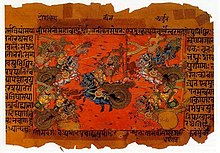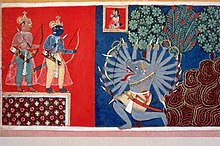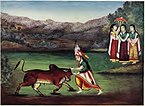Indian epic poetry
| Part of a series on |
| Buddhism |
|---|
 |
| Part of a series on |
| Hindu scriptures and texts |
|---|
 |
| Related Hindu texts |
| Part of a series on |
| Jainism |
|---|
 |
Indian epic poetry is the epic poetry written in the Indian subcontinent, traditionally called Kavya (or Kāvya; Sanskrit: काव्य, IAST: kāvyá). The Ramayana and the Mahabharata, which were originally composed in Sanskrit and later translated into many other Indian languages, and the Five Great Epics of Tamil literature and Sangam literature are some of the oldest surviving epic poems ever written.[1]
List of longest epics
| Image(s) | Length (lines) | Original title(s) | Romanization | Literal meaning(s) | Original language(s) | Place(s) of origin | Author | Genre | Note(s) |
|---|---|---|---|---|---|---|---|---|---|
 |
1,00,000 couplets (2,00,000 lines) | महाभारतम् | Mahabharatam
|
The Great Bharatam | Sanskrit | Indian subcontinent | Vyasa | Sanskrit literature, Hinduism | [2] |
 |
51,820 lines (60,000 including Nanak Prakash) | ਗੁਰਪ੍ਰਤਾਪ ਸੂਰਜ ਗ੍ਰੰਥ | Gur Pratap Suraj Granth | The Sun-like eminence of the glory of the Guru | Braj Bhasha | The Sikh kingdom of Kaithal | Mahakavi Santokh Singh | Sikh literature
|
|
 |
24,000 couplets (48,000 lines) | रामायणम् | Ramayanam
|
Rama’s Journey or Rama's progress | Sanskrit | Indian subcontinent | Valmiki | Sanskrit literature, Hinduism | [3] |
 |
39,000 lines | ꯈꯝꯕ ꯊꯣꯏꯕꯤ ꯁꯩꯔꯦꯡ | Khamba Thoibi Sheireng | Poem on Khamba and Thoibi | Manipuri ")
|
Manipur Kingdom
|
Hijam Anganghal | Epic cycles of incarnations in Moirang, Meitei literature
|
[4][5][6] |
 |
21,507 | ఆంధ్ర మహాభారతం | Andhra Mahabharatam | The Telugu Great Bharatam | Telugu language | Eastern Chalukyas | Kavitrayam | Telugu literature, Hinduism | |
 |
5,730 | சிலப்பதிகாரம் | Cilappatikaram | The Tale of an Anklet | Tamil language | Tamilakam | Ilango Adigal | Sangam literature | |
| 4,861 | மணிமேகலை | Manimekalai | Jewelled Belt, Girdle of Gems | Tamil language | Tamilakam | Chithalai Chathanar | Sangam literature, Buddhism | ||
 |
3,145 | சீவக சிந்தாமணி | Cīvaka Cintāmaṇi | Jivaka, the Fabulous Gem | Tamil language | Tamilakam | Tiruttakkatēvar | Sangam literature, Jainism |
Hindi epics
In modern Hindi literature,
Apart from Kamayani,
Likewise Lalita Ke Aansoo[7] by Krant M. L. Verma (1978)[8] narrates the tragic story about the death of Lal Bahadur Shastri through his wife Lalita Shastri.[9]
Kannada epics
The
The Prabhulingaleele, Basava purana, Channabasavapurana and Basavarajavijaya are a few of the Lingayat epics.
Meitei epics
The sagas of the seven
The

The Numit Kappa, literally meaning "Shooting at the Sun" in Meitei, is a 1st-century BC Meitei epic, based on the story of a hero named Khwai Nungjeng Piba, who shoots one of the two shining suns in the sky, to create the night.[19]
The Ougri is the collection of musical epic poetries, associated with religious themes, originated during the reign of King
Assamese epics
In 14th century Madhav Kandali dubbed the epic Ramayana as
Sanskrit epics
The ancient Sanskrit epics the
The language of these texts, termed Epic Sanskrit, constitutes the earliest phase of
The Buddhist kavi Aśvaghoṣa wrote two epics and one drama. He lived in the 1st-2nd century. He wrote a biography of the Buddha, titled Buddhacarita. His second epic is called Saundarananda and tells the story of the conversion of Nanda, the younger brother of the Buddha. The play he wrote is called Śariputraprakaraṇa, but of this play only a few fragments remained.
The famous poet and playwright
Tamil epics
The post-
Later, during the
Telugu epics
Most of the Telugu epics are about Hinduism.
The first known Telugu epic was the Andhra Mahabharatam written by the Kavitrayam (11th-14th centuries)
Other main Telugu epics are the
Notes
- ISBN 9788126011940. Retrieved 10 May 2012.
- ^ "Mahabharata | Definition, Story, History, & Facts | Britannica". www.britannica.com. Retrieved 24 April 2023.
- ^ "Ramayana | Summary, Characters, & Facts | Britannica". www.britannica.com. Retrieved 24 April 2023.
- ^ ISBN 978-81-7201-798-9.
His epic Singel Indu was published in 1938 which was followed by his magnum opus Khamba Thoibi Sheireng (1940), a poem of 39000 lines, considered to be the 'national' epic of the Manipuris, written in the Pena Saisak style of folk ballads.
- ^ ISBN 978-81-260-1194-0.
His best work, Khamba Thoibi sheireng, in 39,000 lines on the story of 'Khamba and Thoibi' was started in 1939 and the composition was completed in 1940.
- ^ a b Delhi, All India Radio (AIR), New (31 August 1975). AKASHVANI: Vol. XL. No. 35 ( 31 AUGUST, 1975 ). All India Radio (AIR),New Delhi. p. 1582.
{{cite book}}: CS1 maint: multiple names: authors list (link) - ^ * Book:Lalita Ke Ansoo on worldcat
- ^ Hindustan (Hindi daily) New Delhi 12 January 1978 (ललिता के आँसू का विमोचन)
- Panchjanya (newspaper)A literary review 24 February 1980
- ISBN 81-208-0805-3.
- ISBN 81-208-0805-3.
- ^ "Introduction to Siribhoovalaya, from Deccan Herald". Archived from the original on 28 September 2007. Retrieved 7 March 2007.
- ^ "Usage of Saangathya and frame of 729, from The Hindu newspaper". Archived from the original on 28 September 2007. Retrieved 7 March 2007.
- ISBN 978-81-260-0086-9.
- ISBN 978-0-429-95320-0.
The epics of the seven incarnations Apart from several other works based on the theme of love, mention may be made of the literature coming from the Moirang region of Manipur. A civilization situated on the magnificent Loktak Lake, the culture of the Moirang clan has been noted. Numerous manuscripts of the Moirang region dwell on the theme of love. One of the most popular stories refers to the seven pairs of lovers who are regarded as incarnations of the same souls in different generations or ages. The seven cycles are Akongjamba (hero) and Phouoibi (heroine): Henjunaha (hero) and Leima Lairuklembi (heroine); Khuyol Haoba (hero) and Yaithing Konu (heroine); Kadeng Thangjahanba (hero) and Tonu Laijinglembi (heroine); Ura Naha Khongjomba (hero) and Pidonnu (heroine); Wanglen Pungdingheiba (hero) and Sappa Chanu Silheibi (heroine); Khamba (hero) and Thoibi (heroine).
- ISBN 978-81-7201-324-0.
H. Anganghal Singh's Khamba Thoibi Sheireng (Poem on Khamba Thoibi, 1940) is a national epic of the Manipuris based on the story of Khamba and Thoibi of Moirang. The poet composes the whole epic in the Pena Saisak style of folk ballads sung by minstrels or bards popular in Manipur.
- ISBN 978-81-260-1194-0.
- ISBN 978-81-260-0086-9.
- ISBN 978-81-260-0086-9.
- ISBN 978-81-260-0086-9.
- ISBN 817018858X.)
{{cite book}}: CS1 maint: multiple names: authors list (link) CS1 maint: numeric names: authors list (link - ^ Atharva Veda 11.7.24, 15.6.4
- ^ Chāndogya Upaniṣad 7.1.2,4
- ISBN 978-81-208-0264-3.
- ISBN 978-81-206-1071-2.
- ^ Datta 2004, p. 720
References
- Arthur Anthony Macdonell (1900). . A History of Sanskrit Literature. New York: D. Appleton and company.
- Oliver Fallon (2009). "Introduction". Bhatti's Poem: The Death of Rávana (Bhaṭṭikāvya). New York: New York University Press, Clay Sanskrit Library.
External links
- MAHE Mahabharata Digital Concordance Archived 25 May 2020 at the Wayback Machine by i Department of Philosophy - Manipal]

